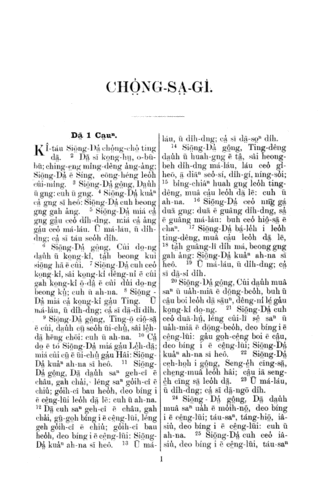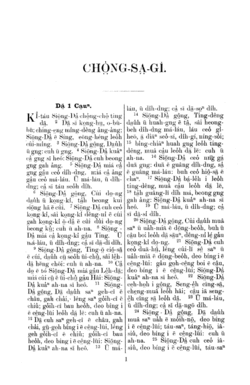Top Qs
Timeline
Chat
Perspective
Hinghwa Romanized
From Wikipedia, the free encyclopedia
Remove ads
Hinghwa Romanized, also known as Hing-hua̍ báⁿ-uā-ci̍ (興化平話字) or Báⁿ-uā-ci̍ (平話字), is a Latin alphabet of the Putian dialect of Pu-Xian Min language. It was invented by William N. Brewster (蒲魯士), an American Methodist pioneer missionary in Hinghwa (modern Putian) in 1890.
Remove ads
Writing system
Summarize
Perspective
Alphabet
Hinghwa Romanized has 23 letters: a a̤ b c ch d e e̤ g h i k l m n ng o o̤ p s t u ṳ.
Finals
Tone
| Tone | Ing-báⁿ 陰平 | Ing-siō̤ng 陰上 | Ing-kṳ̍ 陰去 | Ing-ci̍h 陰入 | Ió̤ng-báⁿ 陽平 | Ió̤ng-kṳ̍ 陽去 | Ió̤ng-ci̍h 陽入 |
| Hinghwa Romanized | none (a) | ˆ (â) | ˈ (a̍) | none (ah) | ́ (á) | ¯ (ā) | ˈ (a̍h) |
| Putian | ˥˧˧ (533) | ˦˥˧ (453) | ˦˨ (42) | ʔ˨˩ (ʔ21) | ˩˧ (13) | ˩ (11) | ʔ˦ (ʔ4) |
| Xianyou | ˥˦˦ (544) | ˧˧˨ (332) | ˥˨ (52) | ʔ˨ (ʔ2) | ˨˦ (24) | ˨˩ (21) | ʔ˦ (ʔ4) |
Example text
Tai̍-che̤ ū Dō̤, Dō̤ gah Siō̤ng-Da̤̍ dó̤ng-cāi, Dō̤ cuh sī Siō̤ng-Da̤̍. Ca̤̍ Dō̤ ta̍i-che̤ gah Sio̤ng-Da̤̍ dó̤ng-cāi. Māng-beo̍h sī ciā da̤u̍h I cho̤̍ ē; hang pī cho̤̍, beo̍ seo̍h-ā̤uⁿ ng-sī ciā da̤u̍h I cho̤̍ ē.
太初有道,道佮上帝同在,道就是上帝。這道太初佮上帝同在。萬物是借著伊造兮,含被造兮,無一樣呣是借著伊造兮。
In the beginning was the Word, and the Word was with God, and the Word was God. The same was in the beginning with God. All things were made by him; and without him was not any thing made that was made. (John 1:1-3 KJV)
Remove ads
Compared with Pe̍h-ōe-jī and Foochow Romanized
| IPA | Hinghwa Romanized | Foochow Romanized |
| pʰ | p | p |
| tʰ | t | t |
| kʰ | k | k |
| p | b | b |
| t | d | d |
| k | g | g |
| tsʰ | ch | ch |
| ts | c | c |
| Tone | 陰平 Ing-báⁿ | 陰上 Ing-siō̤ng | 陰去 Ing-kṳ̍ | 陰入 Ing-ci̍h | 陽平 Ió̤ng-báⁿ | 陽去 Ió̤ng-kṳ̍ | 陽入 Ió̤ng-ci̍h |
| Hinghwa Romanized | a | â | a̍ | ah | á | ā | a̍h |
| Pe̍h-ōe-jī | a | á | à | ah | â | ā | a̍h |
References
- 刘福铸:兴化话罗马字研究
- 高德矞:兴化话与罗马字
External links
Wikiwand - on
Seamless Wikipedia browsing. On steroids.
Remove ads

